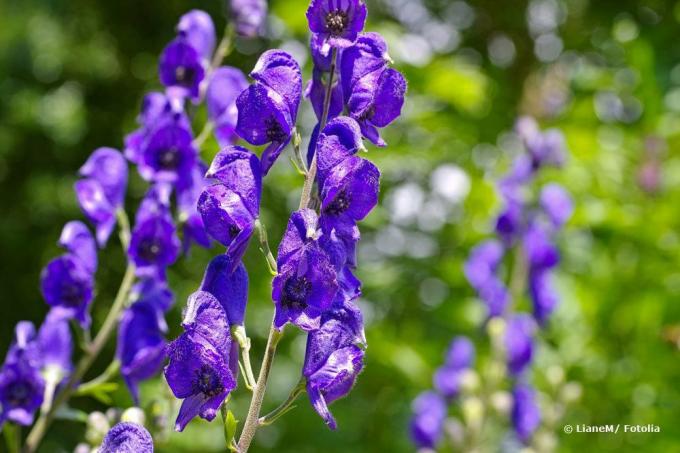
table of contents
- The right location is crucial
- Perennial garden flowers for the sunny location
- Sun hat
- Sham sun hat
- Girl's eye
- Cockade flower
- delphinium
- Lupins
- Hardy flowers for partially shaded locations
- Cranesbill
- Splendid spar
- Asters
- Columbine
- Frost-resistant flowers for the shady garden bed
- Mountain forest cranesbill
- anemone
- Elven flower
- Monkshood
Hardy flowers are the cleverest strategists in the plant kingdom. Her flowers shine on herbaceous shoots that die off before winter. Deep in the ground, the roots survive permanent winter wetness and freezing frost. Just in time for the next spring, the flowers will sprout again in the garden. We welcome you to a foray through the fascinating variety of long-lived bedding plants that transform your green kingdom into a sea of flowers every year. These 70 garden flowers are perennial and hardy.
The right location is crucial
Perennial bedding plants only prove their winter hardiness when they are in the right location. Summer flowers with a preference for sunny locations lead a miserable existence in the shade with moist soil. In return, however, shade bloomers in a sunny location with mostly dry bedding soil lag far behind the floral expectations. As a result, the plants cannot build up sufficient reserves in their roots during the vegetation period to survive the harsh winter unscathed. For this reason, the following selection categorized 70 perennial garden flowers according to the local light conditions in the bed.
Perennial garden flowers for the sunny location
Sun hat
Coneflower (rudbeckia) with bright yellow ray flowers should not be missing in the summer flowerbed. The majestic permanent bloomer is most beautiful in group planting from August until the first frost. The popular summer flowers are not only hardy and perennial, but also act as a popular excursion destination in the garden for bees, bumblebees and butterflies. Beautiful varieties can be discovered under the following names:
- Goldsturm (Rudbeckia fulgida var. sullivantii): Premium variety with yellow ray flowers, 50 to 70 cm
- Gold spring (Rudbeckia laciniata): filled, light yellow flower balls, 70 to 80 cm
- Autumn sun (Rudbeckia nitida) with lemon yellow umbrella flowers, 180 to 200 cm

Sham sun hat
At eye level with the floral opulence of Rudbeckia (Echinacea), Echinacea varieties come up trumps in the sun-drenched garden bed. The term false sun hat should not diminish the fantastic long-distance effect of the impressive flowers, because they are definitely not a second choice. This also applies to endurance and longevity, because sham sun hats are just as hardy and perennial as sun hats. These varieties deserve a regular place in the garden:
- Tangerine Dream (Echinacea purpurea): large, semi-double flowers in bright orange, 75 to 110 cm
- Hot Papaya (Echinacea Hybrid): boasts red, double pompom flowers from June to October, 80 to 90 cm
- Summer Cocktail (Echinacea Hybrid): multicolored variety with yellow, orange and purple flowers, 90 to 100
- Sunrise (Echinacea Hybride): pale yellow blooming summer hat with turned back petals, 70 to 80 cm
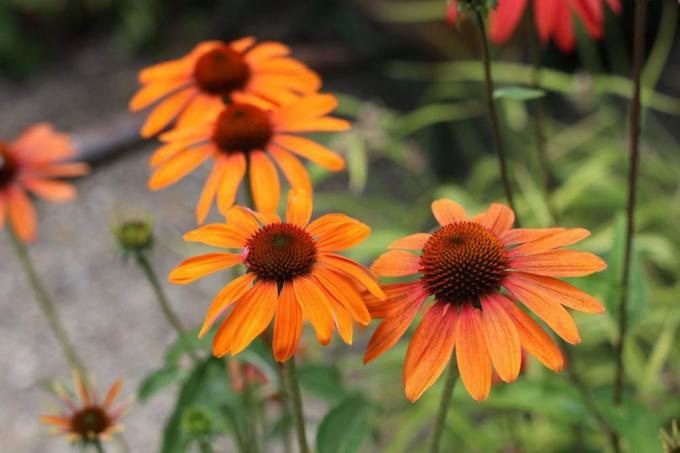
Girl's eye
A girl's eye (coreopsis) with sun-yellow fringed flowers is a special summer beauty. Over the years, decorative flower carpets develop that transform the garden into a sea of flowers from May / June to September / October. The following varieties demonstrate the diversity that can be found in the floral details of girls' eyes. All of the distinctive flowers are perennial and hardy down to -23.3 ° C:
- Early sunrise (Coreopsis grandiflora): semi-double flowers, 45 cm
- Christchurch (Coreopsis grandiflora): yellow ray-flowers with a red wreath in the heart, 50 cm
- Sterntaler (Coreopsis lanceolata): ribbed, yellow petals with a red-brown center, 25-50 cm
- Zagreb (Coreopsis verticillata): yellow ray-florets over needle-fine leaves, 25-30 cm
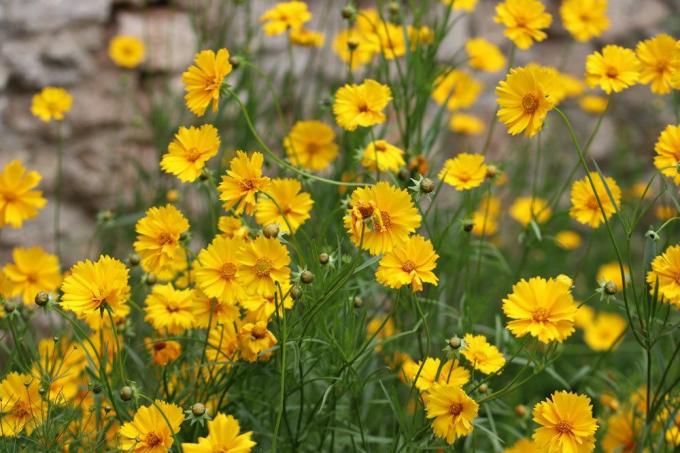
Cockade flower
The colorful cockade flower (Gaillardia grandiflora) repeats its furious appearance on the garden stage every year with a flowering period from July to October. The sunnier the location, the brighter the large, red-yellow flower wheels shine. Adjacent flowers then have to pull out all the floral registers in order not to be overlooked. The cockade flower combines its aesthetic advantages with robust frost resistance, because it is hardy to -20 ° C. Before the onset of winter, the summer flower retreats into the ground and sprouts again in spring. These strains are at the top of the popularity list:
- Kobold (Gaillardia grandiflora): red ray-flowers with yellow tips, compact 30 cm in size
- Burgundy (Gaillardia grandiflora): deep red flower wheels with a dark red center, 40-50 cm
- Tokajer (Gaillardia grandiflora): flowers with iridescent orange tones, 70 cm

delphinium
Larkspur flowers (Delphinium Belladonna) with a variety of varieties are very popular for the authentic design of the cottage garden. When choosing, gardeners can draw on the full, because the lush perennials are all perennial and hardy. The stable hybrids also cause a sensation because they are the same twice bloom per season. The floral stroke of genius succeeds when the gardener prunes the flowers back to ground level after the first bloom from June to July. Then the flowers put on their blooming dress again in October. The only downer with the following selection of varieties, however, are the poisonous juices that flow through the flowers.
- Atlantis (Delphinium Belladonna Hybrid): bright blue flowers, 80 to 100 cm
- Ball gown (Delphinium Belladonna hybrid): light blue flowers, 120 cm
- Green Twist (Delphinium Elatum-Hybrid): white-green, lush double flowers, 120 to 160 cm
- Sweethearts (Delphinium elatum hybrid): semi-double pink flowers with white eyes, 120 to 160 cm
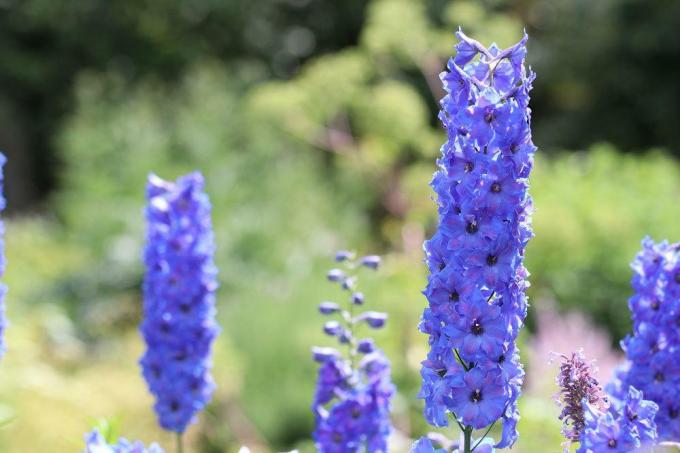
Lupins
The imposing flower candles of lupins (Lupinus) are among the most beautiful bedding plants for the summer garden. From June onwards, the numerous individual flowers unfold from bottom to top. In July and August the flowers present themselves from their most beautiful side until they gradually retreat in autumn. A wide range of picturesque varieties leaves nothing to be desired. Whichever lupins your gardener's heart beats for, they will remain loyal to you for many years, because the bedding plants are hardy to -40 ° C.
- Castle woman (Lupinus polyphyllus): pink flowers with a white flag, up to 80 cm high
- Cardiol (Lupinus polyphyllus): purple-violet premium variety, up to 100 cm high
- Fräulein (Lupinus Polyphyllus-Hybrid): creamy white flower candles, up to 80 cm high
- Gladiator (Lupinus polyphyllus Westcountry series): light red flowers with a yellow flag, up to 60 cm high
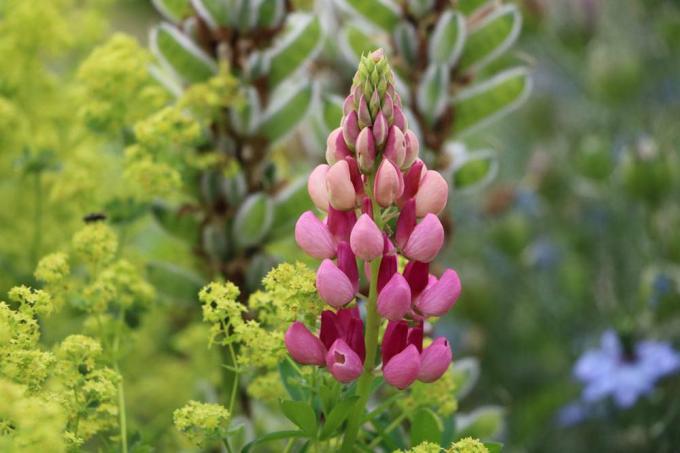
Hardy flowers for partially shaded locations
Cranesbill
Are you on the lookout for lavish flowers for the partially shaded location that are perennial and hardy in nature? Then you come to cranesbill (Geranium) not over. Diverse varieties round off the bed design for the garden decoratively. Some even develop into expansive bushes, others boast compact growth or an extra long flowering period. When it comes to longevity, of course, the flowers pull together. Because they are hardy to -20 ° C and present their abundance of flowers for several years in every garden. In order to demonstrate the diversity within the cranesbill genus, we have put together the most beautiful varieties for you:
- Blue Sunrise (Geranium hybrid): blue-white flowers from June to September, 30 to 40 cm
- Plenum (Geranium himalayense): double, light purple flowers in June and July, 30 to 40 cm (hardy to - 34.4 degrees)
- Pyrenean cranesbill (Geranium endressii): pink flowers from June to August, 40 to 50 cm
- (Geranium Hybrid): plum-colored, darkly veined flowers from June to October, 30 to 40 cm
- Spessart (Geranium macrorrhizum): historical variety with white-pink flowers and fragrant leaves, 25 to 35 cm
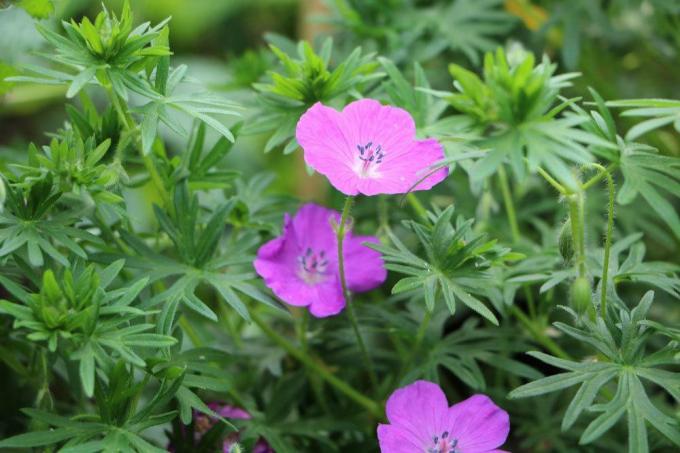
Splendid spar
The penumbra is the territory of the splendid spar (Astilbe). Because a solar yield of 3 to 4 hours per day is enough for the beautiful flower panicles to prove what the plant name promises. So much floral beauty isn't limited to a single variety. Because a colorful array of long-lived hybrids does not allow a partially shaded bed in the garden to go empty. How good that astilbe are well hardy up to bitterly cold -28.8 ° C and consequently attract attention in the bed for several years. If you also cleverly combine the varieties with different flowering times, you can look forward to blooming splendid sparrows from June to October.
- Dwarf splendor spar (Astilbe chinensis): violet-pink flowers on creeping shoots, 25 to 30 cm (beautiful ground cover)
- Finale (Astilbe chinensis hybrid): one of the most beautiful varieties with pink flower panicles, up to 40 cm high
- Germany (Astilbe japonica): white flowering premium variety with an upright habit, up to 50 cm high
- Purple lance (Astilbe chinensis var. taquetii): purple-pink panicles over fresh green foliage, up to 100 cm high
- Chocolate Shogun (Astilbe hybrid): white flowering innovation from Japan with chestnut brown leaves, up to 70 cm high
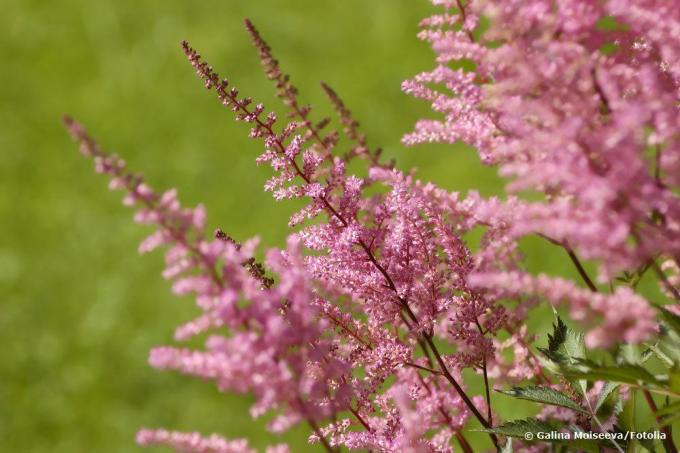
Asters
Asters (aster) accompany you from late summer to late autumn with colorful cup-shaped flowers. The widespread bedding plants favor a partially shaded location in the garden with normal garden soil. The flowers are well hardy and perennial because they know how to stay deep in the ground during the cold season. It is therefore not a cause for concern if the above-ground shoots die off in autumn. In the next spring, fresh stems with new flower buds sprout out of the overwintered root ball. We do not want to withhold recommended aster varieties from you here:
- Pillow aster 'Augenweide' (Aster dumosus): dark blue flowers with a red sheen, 20 to 25 cm
- Forest aster 'Tradescant' (Aster divaricatus): white flowers from August to October, 30 to 50 cm
- Smooth-leaf aster 'Schneekuppe' (Aster laevis): half-double, white flowers in autumn, up to 100 cm high
- Golden-haired aster (Aster linosyris): golden yellow, half-double flowers from August to October, up to 60 cm high
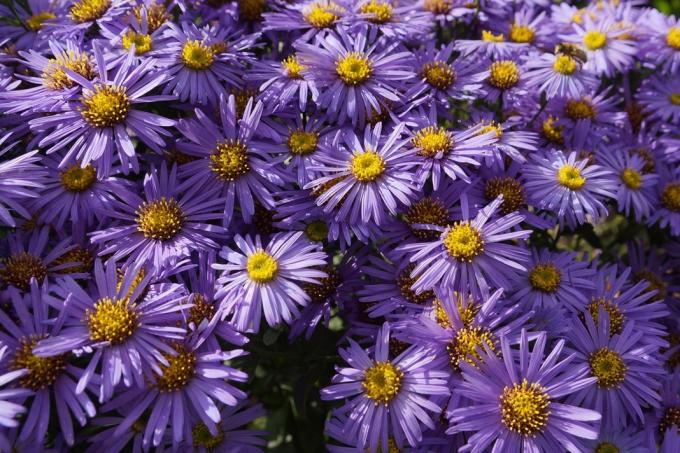
Columbine
Native flower species are naturally hardy and perennial, such as the magical columbine (Aquilegia). The flowers dance with filigree ease through the early summer garden. In the sunny perennial bed and on the partially shaded edge of the wood, the numerous varieties enchant with their beautiful flower colors. Together with summer and autumn blooming flowers, for example, the following columbines open the gardening season in May and leave no unsightly gaps in the bed at the end of the blooming period:
- Maxistar (Aquilegia caerulea): yellow spring flowers with long spurs, 60 to 70 cm
- Dark Columbine (Aquilegia atrata): black-violet flowers with a curved spur, up to 50 cm high
- Blue Star (Aquilegia Caerulea-Hybrid): blue-white, large flowers, 60 cm (extra hardy up to - 40 degrees Celsius)
- Mini-Star (Aquilegia flabellata): small, blue-white beauty from Asia with a graceful 15 cm in height
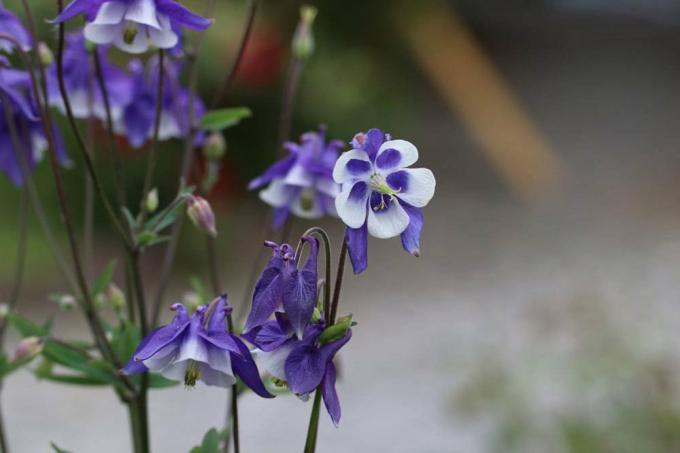
Frost-resistant flowers for the shady garden bed
Mountain forest cranesbill
The robust varieties of the mountain forest cranesbill (Geranium nodosum) are there for cheerful splashes of color in the light-poor bed. Because in contrast to their conspecifics for partially shaded locations, the flowers are satisfied with a significantly lower light yield. The perennials make up for the comparatively restrained abundance of flowers with a never-ending flowering period from May to October and a robust frost resistance down to -28.8 ° C. So there is no doubt that each of the following premium varieties will thrive for several years:
- Pure species (Geranium nodosum): lilac-pink, dark-veined flowers, 30 to 50 cm
- Silverwood (Geranium nodosum hybrid): pure white flowers, 30 to 50 cm
- Clos du Coudray (Geranium nodosum hybrid): purple flowers with a white throat and white border, 30 to 50 cm
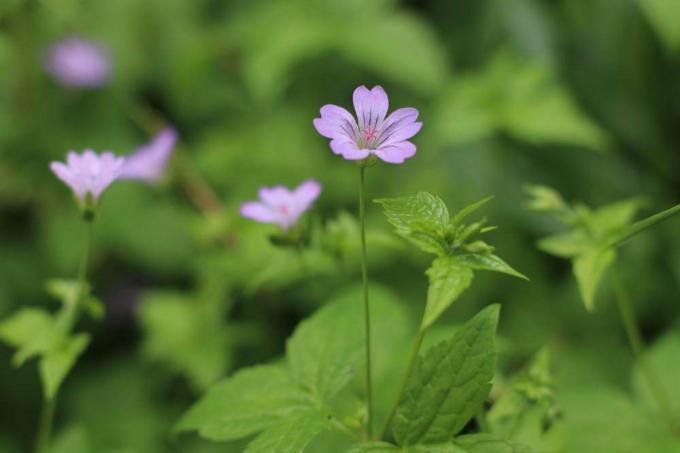
anemone
Anemones (Anemonopsis) found their way from the mountain forests of Japan to Central Europe, where they took the hearts of gardeners by storm. The Asian bedding plants owe their triumphant advance not least to their special talent, far from their homeland, being hardy and flourishing for several years in partially shaded locations. The following anemone varieties stood out in particular:
- Wood anemone (Anemone nemorosa): early anemone with white flowers from March, 15 to 20 cm
- Japan mock anemone (Anemonopsis macrophylla): lovers flowers with purple-pink flowers on arched stems, 50 to 80 cm
- Margarete (Anemone japonica): Autumn anemone with dark pink shell flowers and a yellow center, 70 to 90 cm
- Wild Swan (Anemone japonica): magnificent autumn flowers in innocent white, 45 to 50 cm (valuable bee pasture)
- Overture (Anemone hupehensis): the earliest autumn anemone with pink flowers from July, 80 to 110 cm

Elven flower
Persistent flowers as underplanting of deciduous trees are rare in the plant kingdom. Because where the sun only twinkles through the dense canopy from time to time, true survivors are in demand. Elven flowers (Epimedium) are exemplary in this regard, because they bloom with filigree lightness in shady locations. At the same time, they are hardy to -28 ° C, although the perennials wear their foliage until late winter. If you are still missing representative bedding plants in the planting plan for the shade garden, which at the same time delight the eye for several years, we would like to recommend the following types of flowers to you:
- Amber Queen (Epimedium hybrid): light yellow flowers and a yellow margin, 20 to 35 cm (tolerates root pressure under trees)
- Black Sea (Epimedium pinnatum): light apricot colored flowers, 30 to 35 cm (particularly hardy and vigorous)
- Fluffy elven flower (Epimedium pubigerum): cream-colored flowers, 20 cm (also reliably perennial as underplanting)
- Frohnleiten (Epimedium perralchicum): sulfur-yellow flowers over leathery-brown, evergreen leaves, 20 to 35 cm

Monkshood
Monkshood (Aconitum napellus) is one of the forest shrubs. The imposing flowers are therefore used to grief in the low-light location. Thus, a partially shaded to shady location cannot prevent the perennial bedding plants from showing off impressive flower clusters. Winter hardy down to -40 ° C, the flowers survive the cold season unscathed because they pull in their long flower stalks in good time. The following varieties have proven their ability to flower in partially shaded to shady gardens for generations. The beauties of flowers are of course not suitable for the family garden because they are classified as highly poisonous.
- Wolf's monkshood (Aconitum vulparia): light yellow flower clusters in summer with re-flowering in autumn, up to 80 cm
- Snow White (Aconitum napellus): white flowers in July and August and in October, up to 100 cm
- Cloudy (Aconitum carmichaelii): blue-white, helmet-shaped flowers in autumn, 60 to 120 cm
- Blue Lagoon (Aconitum cammarum): blue flowers in all sunny to shady locations, up to 100 cm
- Franz Marc (Aconitum cammarum): stable premium variety with up to 40 cm long, blue flower clusters, up to 150 cm
